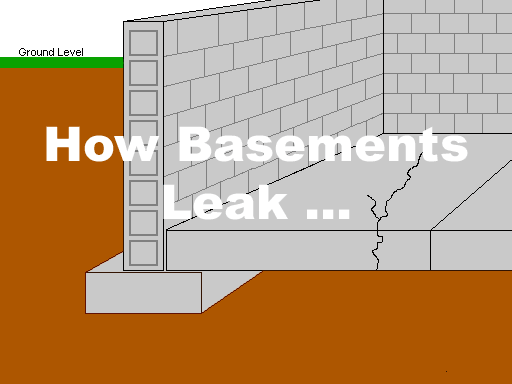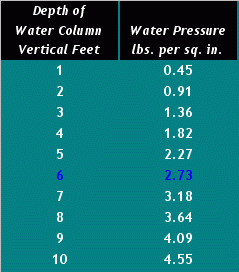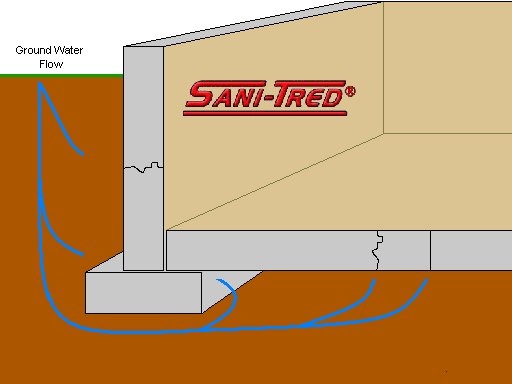 Basement Sealing from the inside requires that the sealant product must be able to retain “negative hydrostatic pressure”. Negative hydrostatic pressure is water pressure that passes through the substrate and presses on the back side of the coating. Constant hydrostatic pressure from the side walls or from beneath the footing and floor will never detach Sani-Tred products when sealing exterior basement walls. They will not peel, blister, chip, delaminate, or detach from concrete, concrete block, mortar, stone or wood even in the constant presence of negative hydrostatic water pressure on a “raw edge” (the starting or stopping point of the coating.) Sani-Tred is the only complete basement or foundation sealing system in the world with the ability to retain “negative hydrostatic pressure”.
Basement Sealing from the inside requires that the sealant product must be able to retain “negative hydrostatic pressure”. Negative hydrostatic pressure is water pressure that passes through the substrate and presses on the back side of the coating. Constant hydrostatic pressure from the side walls or from beneath the footing and floor will never detach Sani-Tred products when sealing exterior basement walls. They will not peel, blister, chip, delaminate, or detach from concrete, concrete block, mortar, stone or wood even in the constant presence of negative hydrostatic water pressure on a “raw edge” (the starting or stopping point of the coating.) Sani-Tred is the only complete basement or foundation sealing system in the world with the ability to retain “negative hydrostatic pressure”.
For detailed instructions on how to waterproof exterior basement walls and instal Sani-Tred, click here.
How & Why Sani-Tred Products Permanently Retain Negative Hydrostatic Pressure
Three unique properties allow Santi-Tred products to retain negative hydrostatic pressure unlike any other products in the world; Flexible Penetration Technology®, Elongation Memory Technology® and Permanent Flexibility®.
Sani-Tred Permaflex®, (liquid rubber primer and top coating), penetrates deeply into the pores of the substrate, (foundation building material), and produces tiny solid rubber sealing plugs due to Flexible Penetration Technology® . These tiny plugs or sealing tentacles penetrate deeply into each and every pore or small crack in the substrate and holds back and retains ground water pressure before it has a chance to reach the Sani-Tred coating surface to push it off, en masse, as with other types of coatings. These sealing tentacles work like tiny, high pressure, hydraulic o-rings and one of the main qualities that allows Sani-Tred to hold back great pressure without failure!
Elongation Memory Technology® ensures that when Sani-Tred products are compressed and relaxed, they maintain their original shape and size preventing distortion of their original shape and size which is a major cause of release of coatings from powerful forces such as freeze/thaw cycles, water or gas pressure, vibration and sudden shock.
Permanent Flexibility® provides that Sani-Tred products never harden or become brittle; they maintain flexibility and only become stronger with age without breaking down as other coatings do. Sani-Tred Permaflex deep penetrates and strengthens weak concrete or mortar joints which prevent detachment from these types of weak substrates as other coatings are known to do.
Sani-Tred Products Have No Equal and Must Contend with Obsolete Testing and Measurement Criteria
Pressure or vacuum testing procedures for materials often used for negative hydrostatic waterproofing in the past are designed for cement based materials and actually allow steady leaking to actually “pass testing” as a “negative waterproofing” product.
The Sani-Tred system is so advanced that standard ASTM testing procedures are unfit to compare Sani-Tred with other obsolete products commonly used for “negative waterproofing”. Standard ASTM testing for negative hydrostatic pressure allows for a rapid drop in pressure or vacuum, (leaking), over a short period of minutes of time and is designed to allow cement based waterproofing materials to “pass” as a “negative waterproofing material” even though they always leak.
During the same testing of Sani-Tred products there is virtually no leaking of pressure or vacuum over days or weeks of pressure testing, yet a cement based material that leaks like a sieve will have the same passing grade of an ASTM test as Sani-Tred with zero leaks!
Common sense dictates that a waterproofing product should provide zero leaking to be considered suitable as a negative waterproofing product.
LRB/TAV mixture molecularly welds to the Permaflex to act as reinforcement to seal large cracks, joints, holes, etc. These are some of the unique characteristics that give Sani-Tred the ability to retain “negative hydrostatic pressure”, moisture vapor drive, and radon gas at greater pressure than any other products in the world.
The photos below show a concrete patio block that was laid horizontally and coated on one side with Sani-Tred PermaFlex. The PermaFlex was reduced with Xylene (solvent) to allow quicker and deeper penetration. Once this coat was completely saturated, more was applied, and repeated. The PermaFlex was tinted red to allow better visual detection of the Sani-Tred microscopic penetration process of Flexible Penetration Technology®. The block was then broken in half to show its internal cross section. Notice the penetration of the red PermaFlex throughout the entire block.
Permaflex “deep penetration, o-ring fingers” seen here penetrating about 1-1/2″
Water Pressure Vs Depth
Sani-Tred is about 60 times stronger than it needs to be!
To understand how strong the Sani-Tred system actually is you must know the maximum water pressure, (psi.), your basement walls and floors could possibly be exposed to under the most realistic extreme conditions.
The Floor of An Average Residential Basement, with a Window, Would Be About 6′ Below Outdoor Ground Level.
 EXAMPLE: Worst Case Scenario; let’s say that the ground around your basement is totally saturated with water. This would be almost the same situation as if your basement were submerged in a large tank of water all the way to ground level up to the windows! Using the standard formula for pressure and depth (Pressure equals depth times 15 divided by 33). Examine the chart above: You see, the average basement wall or floor could have only 2.73 psi. Pressure maximum! Sani-Tred independent lab testing has rated our 1/16″ thick system capable of withstanding 10 psi. This means that theoretically our standard 1″ LRB/TAV basement sealing bead should withstand a maximum of 160 psI!
EXAMPLE: Worst Case Scenario; let’s say that the ground around your basement is totally saturated with water. This would be almost the same situation as if your basement were submerged in a large tank of water all the way to ground level up to the windows! Using the standard formula for pressure and depth (Pressure equals depth times 15 divided by 33). Examine the chart above: You see, the average basement wall or floor could have only 2.73 psi. Pressure maximum! Sani-Tred independent lab testing has rated our 1/16″ thick system capable of withstanding 10 psi. This means that theoretically our standard 1″ LRB/TAV basement sealing bead should withstand a maximum of 160 psI!
In actual field installations the system has withstood measured hydrostatic and/or vapor pressures of up to 40 psi without failure!
This means the standard Sani-Tred basement or foundation sealing system is approximately 60 times stronger than required to seal the worst basement under the worst possible conditions such as a basement with large cracks, holes or joints.
We have demonstrated above that the worst ground water pressure or “negative hydrostatic pressure” forces on your basement are not high pressure but it is a constant force which is continuously trying to push coatings from the surface of concrete. Don’t you want the strongest toughest and most durable products available on your basement walls and floors?
Sani-Tred products have passed over 20 years of field testing and research in underground water vessels such as basements, deep cisterns, elevator pits, swimming pools, and manholes. This field testing and research is coupled with a rigorous independent testing regimen designed by “The American Society of Testing and Materials, or (ASTM). These independent tests have proven that Sani-Tred products exceed the minimum requirements for negative pressure retention by many times over!
- Negative Hydrostatic Vacuum ASTMC-1244 RESULTS 5 min. @ 12 in.
- Negative Hydrostatic Air Pressure Rev. ASTM C-1244 RESULTS 5 min. @ 10 lbs.
Understanding the Relationship of Pressure and Coating Surface Area
The more the tiny, Permaflex flexible, rubber tentacles are compressed by ground water pressure the greater the seal! It’s a mechanical fact that the smaller the diameter of a tube, pipe, hose etc, the greater the pressure force it may retain.
Example: a specific length of seamless copper tubing 1/8″ in diameter with a wall thickness of .065″ is rated to handle up to 3,675 pounds per square inch of pressure, (psi). On the other hand, the exact same length of copper tubing with a much larger diameter of 2″ with the exact same .065″ wall thickness is rated to handle only 299 (psi) explained by the formula illustrated below. Ref: “American Society of Mechanical Engineers” Code for Pressure Piping (ASME B31):
- WHERE: P = allowable pressure, psi
- S = maximum allowable stress in tension, psi
- tmin = wall thickness (minimum), in.
- Dmax = outside diameter, in.
- C = a constant
This example may help you to understand the negative waterproofing significance of Sani-Tred products. This should also illustrate why it is necessary to reinforce large cracks, holes, and joints with our “adhesive rubber caulk” known as LRB and TAV mixture to work with the pressure retention abilities of the Permaflex primer which handles the small or microscopic levels of sealing and adhesive bonding to the substrate. NEVER USE CEMENT BASED PATCHING MATERIALS! The Sani-Tred basement waterproofing system relies upon the application of LRB and TAV mixture to reinforce Permaflex in large holes, cracks, joints and other such larger potential and visible leaking areas allowing Permaflex to handle the tiny microscopic leaking areas.
Sani-Tred Permaflex obviously cannot penetrate materials such as native stone, fired brick, ceramic tile, steel, glass or other such non-porous materials but does penetrate and seal all mortar joints to produce a negative hydrostatic seal. This is especially important when these types of non-porous building materials are incorporated in a concrete or mortar jointed foundation wall such as iron pipe through a poured concrete wall or a stone foundation. The use of Sani-Tred Permaflex primer with LRB and TAV mixture effectively seals these normally difficult to waterproof surface areas.
Most exterior sealing methods are of little value in preventing water from entering the basement as you can see by studying the basement cut-away sketches. Concrete walls can’t be damaged merely from direct contact with ground water. Only if water can flow through concrete is water detrimental to the structural strength of non reinforced concrete. Therefore, exterior concrete walls will not be damaged by mere contact with ground water and don’t require waterproofing.
Longevity of Sani-Tred Basement Waterproofing
Sani-Tred’s custom designed polyurethane molecules or artificial rubber is among the most complex molecules known to man. This is what allows the flexible nature of the material and provides Sani-Tred’s remarkable durability. Since the early invention of the automobile there has been an effort to find a good way to dispose of old tires. Old worn-out tires have been directly buried in the earth for over 100 years, unearthed, only to discover that they were in as good condition as when originally buried!
By these observations scientists have determined that the best possible environment to keep and maintain rubber products, both natural and artificial, is to keep them in a damp environment in the absence of UV exposure. Under these conditions it has been determined that natural or artificial rubber will last virtually forever without breakdown or deterioration. These are virtually the same conditions found inside a concrete basement wall. This is one of the many reasons we can so confidently make the statement “permanently waterproof your basement” and you can have confidence in our lifetime warranty.
The oldest Sani-Tred installation, an outdoor commercial floor surface, is over 21 years old, in a heavy foot and light vehicle traffic UV exposure, environment with no signs of breakdown or substantial wear.

